The Twisted Tale of Talgo
Settlement forces state to pay more for trains it didn’t get, leaving it with slower Amtrak trains.
Settlement forces state to pay more for trains it didn’t get, leaving it with slower Amtrak trains. Back to the full article.


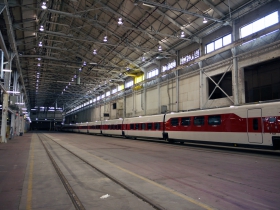
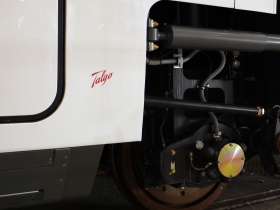
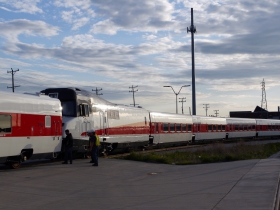
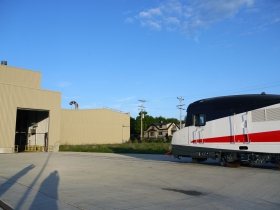
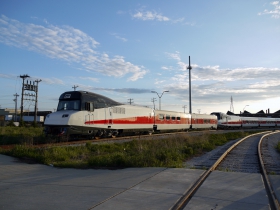
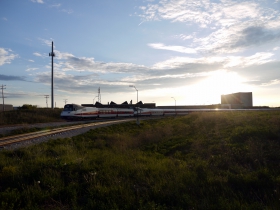




















Really? I don’t think the $810m covered to the Twin Cities. Options for that route are still being debated today. Maybe it allocated some funds towards research or early design, but certainly not construction. Unless you mean the early (and stupid) version of the the route in Madison that turned away from downtown and went northwest to the airport with dreams of reaching TC…
That’s some sly negotiating on the part of the state. Separately, another source said the sale price has to be $32.5 million (http://www.scrippsmedia.com/nbc26/news/State-settles-unused-trains-lawsuit-for-nearly-10-million-322427131.html)
Lots of numbers flying around…Worth calling out the Milwaukee Intermodal Station upgrades that the State is paying for right now. Cited JS source pegged that at $20.4 million in 2011.
Anyone ever ask if it’s because of this that Walker sided with the new arena and coined the slogan “cheaper to keep them?” Cause it sounds like there was a lesson learned in all of this.
@Rich I’ve corrected the story. The $810 was to only to get to Madison. Though it was always as part of a larger plan to get to the Twin Cities.
Halfast trains are disaster round world, look at Ca. We saved at least a billion dollars that would have gotten us a halfast train with service only to Madison> Buses go faster and can go right to Capitol. Another reason why Milwaukee is such a mess cause they buy trolleys, arenas instead of cops and reading for kids plus better roads. Half are in really bad shape. Dopey Left idea, no wonder they are out of power..
Jill Bader, Scott Walker’s Spokesperson, tweeted a (dog whistle) racist comment in the form of a YouTube video, which had apparently been making rounds in the conservative blogosphere and comments. The bottom line is that Walker spent our tax dollars to keep African Americans from access to jobs in the predominantly white suburb of Waukesha. Waukesha has been paying him back ever since. https://www.youtube.com/watch?feature=player_embedded&v=A_Zi-YSW3aQ
How can a thinking person even entertain voting for Walker. He is too stupid to be believed. I can’t imagine why Wisconsinites voted this STUPID snake into office. His not fit to walk my dogs.
As often as the Hiawatha stops and slows for local speed restrictions, having faster trains wouldn’t matter. Pedal trains could cover the distance as quickly. High-speed rail will never be high speed in WI because the locals won’t allow it. When Tommy “Amtrak” Thompson tried to get HSR moving, community after community nimbied high speeds. Gentleman Jim’s luck of the Irish couldn’t turn the tide. HSR is wishful thinking in W, no matter who pays for the line.. Surely, Shirley, you knew that when you came here. Your croupier’s shift ended, leaving no one to stop the little ball on 00 Green for you.
WCD, California’s HSR is nothing like Wisconsin’s and therefore it doesn’t predict what would have happened in Wisconsin.
California’s HSR:
• 220 mph
• Electric trains (new electrical infrastructure)
• 2-4 track (minimum) lines
• All new route (lots of land acquisition and eminent domain)
• Lots of tunneling (more added monthly to satisfy NIMBYs)
• Railroad car designs never before used in US
• Mostly local capital funding
Wisconsin’s HSR to Madison:
• 110 mph
• Diesel trains
• single-track west of Watertown, 2-track elsewhere
• No new routes
• No tunneling
• Railroad car designs used in Oregon/Washington for years
• 100% federal capital funding (including overruns up to $130 million)
Let’s get a few things straight. First off, the initial run from Downtown Milwaukee to Dane County Airport while projected at $1 billion, was already moving closer to $1.5 billion with the Feds only kicking in $800,000,000,,, only…. Moving the proposed route to downtown Madison, requiring a rather vast section of private property increased the costs by an additional $1 billion. So we are, in infrastructure alone at $2.5 billion while the feds only kicked in $800 million. Then you take into account the Talgo scams done by Doyle and supported by Barrett. GE, one of Wisconsin’s larger builders has a rail division based in the USA. The passenger cars could have been built here in Wisconsin by Super Steel. But Diamond Jim decided to give a no bid contract to an unknown foreign rail builder with a questionable safety history. Then when people asked why we bought trains he claimed they were for a Federal program, Amtrak. By the way, at the time, Amtrak didn’t want them either because the high speed trains were not designed for running on freight tracks. That’s another misnomer, these would never be the high speed trains like the left always talks about in Europe. Our rail beds are rated for 65 mph. Legally, they can’t or shouldn’t go faster. When it comes to the run to Minneapolis, the left always talks about this but never shares the real costs or plans publicly because it’s never going to happen. If someone’s going to take a car speed train, why not just drive in the first place. That way you don’t have to rent a car when you get there. You just drive there…
@WCD.
Yes, put all your eggs in one basket. Spend all our transportation money on roads. And by the way, stop the clock permanently. We don’t want that damn future, because it scares us. Will conservatives ever embrace progress, or is this nation destined to sink in the mire of complacency. You are the 21st century version of Ludites.
Greg, it seems all the progress in transportation the left is pushing comes from the 1800s. Doyle knew that Walker was going to stop this waste of money, but he pushed it through thinking once started it couldn’t be stopped, same thing Barrett is doing in Milwaukee with his asinine Trolley.
That’s a whole lot of assertions, Jim, with zero citations. I would expect no less from a Republican, though. By the way, you might want to look up Super Steel’s track record on building passenger rolling stock. Hint: not good. At all.
If the teaching is so great & pays so well, why do we have trouble finding teachers that can take impoverished, aimless, and/or violent children & get them to value getting themselves educated/trained for their future?
Hmmm… maybe we should just settle for warehousing them until they either get themselves locked up or find one of the many opportunities available to uneducated youth here… like the exciting world of part-time cellular sales.
I wonder which option Wisconsin is choosing?
While it was awful that these trains and this plan was destroyed for now it at least looks like the anti-streetcar groups second petition is imploding. They were frothing at the mouth and confident when it started but haven’t posted to their Facebook page since 7/29 and the people are panicking. No mention of signatures, no blustering, less than two weeks until we can stick a fork in them on Labor Day. They can’t stop the momentum and the expansions WILL happen. Milwaukee WILL reinvent itself.
Interesting to see history re-invented; I lived through this one, too.
The 65 mph railbeds would have been upgraded in the future as money becomes available. The Feds require overpasses or tunnels when a train’s speed is to exceed, I believe, 110 mph. If one wishes to criticize the “high cost” of implementing rail it might be a bad idea to undercut your own argument by complaining that the first step is “too small.”
So, yes, it would have profited Wisconsin to keep the trains, run them, use the already negotiated federal money for the Intermodal station gates make-over. And then wait for the (Walker-promised) spurt in our economy to consider the next upgrade. That’s how planning in a budget is done.
Streetcar, case in point, the critics would avoid looking at the larger plan which will cost hundreds of millions down the line, but they will complain that the design is a “downtown trolley.”
Tim, about your exaggerations about the speed of the Hiawatha. Comparing it to a pedal tavern!! (very funny) Perhaps you hope no one in your reading audience has ever used Amtrak to Chicago? (very obvious) Or are you sharing most riders’ wish Amtrak could have its own right of way? I do agree. (very emphatically) But really, Tim, on behalf of actual Amtrak users, may I explain to you that the Chicago run compares to and often exceeds auto travel time. It costs less than gasoline and downtown Chicago parking. (miser here) And it’s well subscribed; so get on board and help us add another run to Chicago.
Bill Sell
One of the main reasons we are against the trolley is because of the hundreds of millions of dollars more it will cost
The only reason the Milwaukee to Chicago trip is cost effective to the riders is because of the government subsidies
Planning a budget is done by not wasting money on bad ideas
@Paul
It’s a good thing then that you can’t stop the streetcar. The second petition even acknowledges that by not even trying to stop it (because legally direct legislation (ie petition) can’t stop already passed legislation). From what I hear the second petition is failing miserably too with no posts of support or anything out of the Facebook page since 7/29. Ding dong the second petition effort is dead!
And the angry challengers to Witkowski and Murphy will likely fail too along with Bathroom Bob Donovan’s mayoral campaign so it’s destined to be expanded.
This is all coming from a conservative who isn’t blinded by hatred to the city like many of the people who live in the suburbs like me. Milwaukee is re-inventing itself. Arena and entertainment district, The Couture, NM’s building along with their mixed use building, JCI tower and many other developments.
Such clarity is a public service.
Paul, I’m curious. Are you a City of Milwaukee resident?
Observor, I’m curious why don’t you use your real name?
Ryan, I’m for a strong and vibrant Milwaukee, that’s the reason I don’t want them to go bankrupt spending hundreds of millions on a trolley that will be nothing but a money pit
@Paul
You calling it a trolley when it’s not shows that you don’t know what you’re talking about. “Trolley” is a slur against the streetcar used by people who don’t really know the facts of the situation. Plus, transportation is always subsidized and will NEVER pay for itself. Roads are the most heavily subsidized and so are the buses and so will the streetcar. Money isn’t the only benefit to a strong public transit system.
Again, you have to spend money to make money and see the benefits.
@Paul
1.) you can criticize Observer for not using his real name as soon as you include your last name.
2.) The streetcar is a trolley the same way a ham sandwich is a piece of pizza.
3.) what about the development that will occur adjacent to or nearby the streetcar that otherwise wouldnt have occurred. The ripple effect from these developments?
Will (no last name ), I just was pointing out that a person that wants to know details about me won’t even post using his or her name. Kind of ironic isn’t it.
Ryan, yes buses and the roads they and everyone else use are subsidized, why spend more money on a system that will cost hundreds of millions to build and lose money every year with no added benefit that cannot be accomplished by expanding the bus system we already have .
Paul, no one who is against the streetcar truly supports expanding the bus system. Everyone was saying that when the streetcar vote happened and then when Abele suggested BRT they all came out saying no more finding for buses and how the routes and funding should be cut further.
It will help transit and be used by a lot of people. Right now it’s iust downtown but it will be expanded for the entire city eventually. Just becaus you won’t get any use out of it doesn’t mean the money shouldn’t be spent. I doubt most people get any benefit out of the roads by your house but you don’t see people trying to eliminate that. I don’t use the buses but I support the funding.
Either way the point is moot. The base streetcar root can’t be stopped, the petition drive will fail miserably and we have the votes for future expansion that Bathroom Bob Donovan can’t stop so it will happen. If you don’t like it and love in the city you can always move to a suburb and never have to pay for it.
Ryan, they said the high speed rail couldn’t be stopped either. Moving to a suburb may not be far enough, the mayor will call for expansion into the suburbs, going to the malls Mayfair, Bayshore,Southridge and Brookfield Square and spread the costs. I’m planning on moving at least two counties away.
Paul, the mayor can’t make unilateral decisions outside the city. It would require county and other local approval. Once the suburbs see the success they’ll want to tap into it. Like the county already wants to do. A few of the conservatives on the county board have said they don’t want to fund it but they want to run it, meaning they think it will be successful.
But that’s awesome that you’ve moving away. We need the people who hate the city to be out of the county and really have no say on what goes on. What people need to realize is without the city the suburbs would be nothing but without the suburbs the city would be nothing. It’s moving in the right direction now though.
And high speed rail will come back eventually, it’ll just cost more then if we had just put it in place. Walker wasn’t even against it fully, he supported it from Milwaukee to Chicago by renovating the Hiawatha line and just stop the extensions to Madison and Minnesota but the out-state hayseed hicks killed it.
Ryan, I love the city, that’s why I want the best for it.
The ” out – state hayseed hicks” would have been paying for this boondoggle and the right thing was done to kill it
Jim (post 9)
Let’s look at some of your assertions.
The total cost of infrastructure (track work, stations, maintenance facility, signals, etc) plus rolling stock(locomotives and coaches) to extend the train from Milwaukee to the Madison airport was something between $600 and $700 million with the feds providing about $800 million (including over $100 million for “contingency” (i.e. cost overruns).
The added cost for rerouting it from Madison’s airport to downtown was expected to be zero or negative. No real estate would be acquired. The tracks are already there and carrying freight trains.
The downtown Madison station would have been in the basement of an existing State-owned office building (at 101 E Wilson Street); the tracks run past the rear of that building. The City of Madison pledged to build a new parking garage across the street (at Madison’s expense).
By moving the station from the airport to downtown, the route became slightly shorter (because, by rail, 101 E Wilson is closer to Milwaukee than is Madison’s airport) so the cost of trackwork to downtown would be lower (or certainly, no higher) than the no-longer-needed trackwork out to the airport.
The “unknown foreign rail builder with a questionable safety history” has been known to Amtrak since 1994 when Amtrak started running their equipment on its “Cascade” trains (Portland-Seattle).
Your statement that “Amtrak didn’t want [Talgo equipment] either because the high speed trains were not designed for running on freight tracks” flies in the face of reality. Amtrak has been using them for over 20 years (and recently started using two new Talgo trains built in Milwaukee) and has been safely using them on freight rail lines.
Your blanket statement “Our rail beds are rated for 65 mph” is absurd. Some tracks are faster (e.g. 79 mph south of Milwaukee on today’s Hiawatha) and some are slower (like the 10 mph tracks that the Madison extension would have upgraded).
If driving is so great, why do so many Wisconsinites take the “car-speed” Hiawatha to Chicago (average speed 57 mph—slower than the Madison-Chicago train)?
Tom D, zero to negative cost to reroute from Dane County Airport to downtown Madison, that’s the funniest thing I’ve heard all day
I stand by what I wrote. I learned about the streetcar, by reading the information, by asking questions, by attending meetings, and (long ago) by actually using street cars and rapid (rail) transit. These are people moving tools that are efficient, cost effective and they do reduce the load on highways which happen to be more expensive per mile per person use than rail of any kind. Now, if you don’t want to read, to learn, to listen to experts, to take information from the evidence provided by cities that built streetcars over the past several decades, I cannot help you or force you. But I have a life and I don’t spend time with people who choose to be lame, ignorant, or blind.
Paul (post 31):
When the Madison train station moved from the airport to downtown, only two costs changed:
• the track (and related items like signals)
• the station building itself
The track cost decreases because moving the station reduces the track needed by about 1.5 miles: while about 1.5 miles was added to the route at the downtown end, about 3 miles of track was dropped at the airport. (Both distances are measured from the existing rail junction just east of First and Main Streets in Madison, where the two routes diverge.)
Now let’s look at the two station buildings. The airport station would be built at the edge of the airport property. It would require new construction and probably new underground utility lines. It might also require land acquisition if there isn’t enough suitable land next to the tracks.
By contrast, the downtown station would be in the basement of a state office building (101 E Wilson St) which sits right next to the tracks. The building already exists and has a full complement of utility lines. Parking spaces would be provided in a new garage across the street, courtesy of the City of Madison.
In summary, there were two new costs incurred by moving the station from the airport to downtown:
• About 1.5 miles of additonal, existing track to be upgraded
• Renovations to the existing building at 101 E. Wilson Street;
There would be two costs that would be avoided by moving the station:
• About 3 miles of existing track that would no longer need upgrading
• A station building that wouldn’t be built
If the Wilson Street renovation could be held to the savings from not building the airport station plus the savings from upgrading 1.5 fewer track miles, the cost would indeed be zero.
The train that mattered was the KRM, not this one, which was about connecting Chicago to Minneapolis through Rochester. Who the fuck needed a train from Milwaukee to Madison? Nobody, of course, but this was never about us — we were just a sidestop in the larger plan. The KRM, on the other hand, WAS about us, and that was killed by Vos and the Racine folks who refuse to get involved with anything that involves tax dollars. We’re stuck in a situation where Racine County has blocked the public great of connecting Chicago to Milwaukee by commuter rail, and Wisconsin has allowed this, despite the METRA and federal funding that has always been available. It’s obscenity politics and it’s a shame we haven’t figured out how to get around it all, though not particularly surprising given the characters involved. Train talk makes me wish Tommy Thompson was still running things.
Per a JS article: http://www.jsonline.com/news/regional-news-briefs-b99562410z1-323040121.html
The Anti-streetcar petition is officially dead. Thank God it’s finally over.
KRM was not CHI to MSP, but rather, CHI to MKE commuter rail a la CHI Metra, which seems to get corrected in the remainder of that posting.
Commentary like that makes you no better than Vos, who killed everything. Why is it only about the train that’s by you? I live in MKE and supported both as transportation options. Consider just momentarily that momentum from either one of those projects being successful would’ve contributed to the other (KRM was first, so the other order is speculation)
Oh, you mean “Turncoat Tommy”, who supported rail before he discovered that more people would pay him to run for office if he said he didn’t?